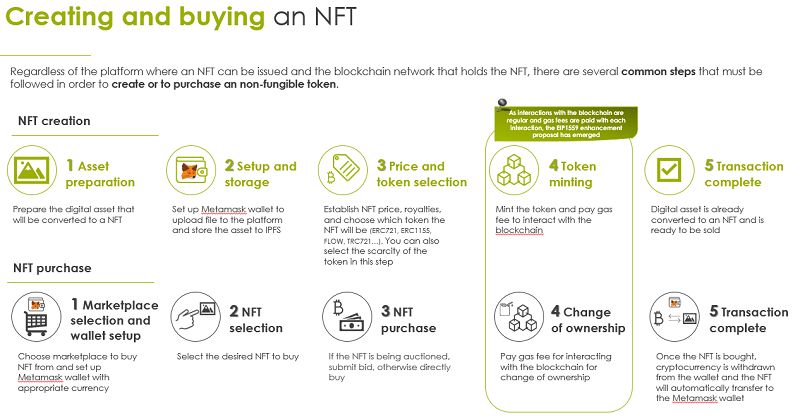An NFT (non-fungible token) is a non-fungible digital crypto asset that represents a unique digital, one-of-a-kind item that cannot be replaced or interchanged, duplicated or divided – creating an impressive digital scarcity.
Mainstream cryptocurrencies (such as bitcoin) can be exchanged for other cryptocurrencies or spent on goods, and exactly like a fiat currency, all cryptocurrency tokens of the same type are identical in specification. In other words, they are fungible.
On the other hand, the unique information of a non-fungible token is stored in its smart contract and immutably recorded on a blockchain. Unlike cryptocurrencies, the value of each token is linked to the perceived value of the underlying asset, making it non-interchangeable with other NFTs.
The non-fungible nature of NFTs has led to some unusual applications of the technology. Recent months have seen digital art soar in popularity – fuelled in large part by NFTs. Earlier this year a New York Times journalist even sold his column (about the rise of NFTs) as an NFT for $560,000.
It would be a mistake, however, for business leaders to dismiss the utility of NFTs as limited solely to representations of digital art.
In fact, Sir Tim Berners-Lee is auctioning his original source code for the web as an NFT. Auctioneers hope that the one-of-a-kind digital artefact will fuel an interest in NFTs beyond artworks, games, and sports memorabilia.
Finance and enterprise applications
There are many potential applications of the NFT model in the financial industry and other enterprise spaces.
Given that NFTs are an indivisible asset class and cannot be split into smaller denominations, they can be used at a fixed price for collateral on bank loans, mortgages, and other debt instruments through smart contracts. Indeed, the significant capital being invested in NFTs has prompted major insurers to begin scoping out opportunities for future insurance products in this area.
On top of this, NFTs can streamline the licensing process by allowing original creators to exercise their proprietorial rights online with minimal paperwork or the administrative burdens of licensing the work; it is inherently encoded within the digital asset’s (NFT’s) smart contract.
This opens the door to a wide array of other opportunities, from more effectively assigning royalties to musicians, to even allowing businesses to use NFTs to monetise access to certain exclusive events or membership spaces.
The future of NFTs in the enterprise space is only just beginning but as highlighted above, there are several exciting, potential applications. Ultimately, building up enterprise use cases will require businesses to get to grips with several key features of NFT technology.
Blockchain, Smart contracts and NFTs
Two key areas define the utility of NFTs: blockchain and smart contracts.
A blockchain is a type of Distributed Ledger Technology (DLT) that enables participants to confirm data and reconcile obligations in a secure, fast and cost-effective manner – thanks to a common and shared transactional database.
Smart contracts refer to the digital representation of an agreement whose execution is both automatable by computer code working with human input and control, and whose rights and obligations, as expressed in legal prose, are legally enforceable. In other words, smart contracts allow transactions to be performed without third parties.
Smart contracts offer the functionality to create NFTs and add them to the blockchain. Each new NFT is assigned a unique ID, enabling transfer from one account to another and allowing users to retrieve the current token balance of an account and get information relevant to a specific NFT.
Understanding the value of NFTs
Across platforms, there are several common steps that must be followed in order to create or purchase an NFT.

The process of creators digitalising an asset or creation via NFT and owners subsequently purchasing said asset, also have key benefits for both the buyer and the seller:
1. NFTs allow for easy and transparent transfers, enabling the original owner the ability (based on the pre-defined settings) to accrue recurring royalties with every transfer as buyers pay you a percentage every time the NFT changes hands.
2. For any given NFT, historical ownership data is stored on the blockchain, which means that everything can be easily tracked back to the original creator, removing space for counterfeits and stealing of assets.
3. NFTs streamline the creator’s distribution process by removing the requirement of any intermediary mediation and removing barriers to entry for creators to digitise, distribute, and sell their creations.
4. Smart contracts are used to store all NFT data on the blockchain which means each token is practically indestructible.
5. Unlike traditional sales of digital creations, when purchasing an asset through NFT it means that the individual who buys the NFT is the owner of the underlying creation, rather than the original creator, providing them a license to consume or use the asset.
Key challenges
Whilst concerns with the NFT system are hindering mainstream adoption, many leaders in the industry are taking steps to mitigate these challenges.
For example, an NFT sale on Ethereum can result in the consumption of 8.7 MWh of energy, twice as high as the average annual consumption for a UK household. In response, The ETH 2 network switched its consensus mechanism from Proof-of-Work to Proof-of-Stake, which assures that the power consumption of the network and the carbon footprint will be improved by 99.98%.
The rise of DeFi and NFTs have increased the number of transactions that are being executed in Ethereum, producing congestion in the Ethereum network. To counteract this trend, developers and NFT artists have diverted to other blockchain platforms such as TRON, Flow and Algorand, that avoid the congestion, load, and gas fees on par with the Ethereum blockchain.
As industry leaders continue to work to combat these challenges, the possible applications of NFTS will continue to expand, unlocking new capabilities and value for businesses across a range of industries.